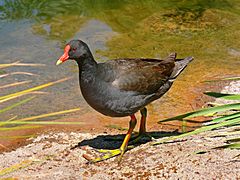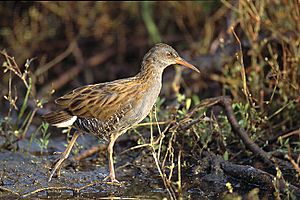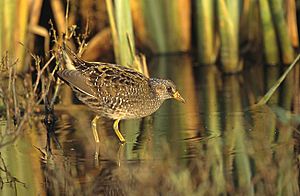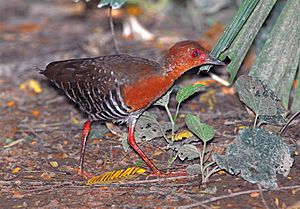Rail (bird) facts for kids
Quick facts for kids RailsTemporal range: Early Eocene – Recent
|
|
|---|---|
 |
|
| Dusky Moorhen, Gallinula tenebrosa | |
| Scientific classification | |
| Kingdom: | |
| Phylum: | |
| Class: | |
| Subclass: | |
| Infraclass: | |
| Superorder: |
Neoaves
|
| Order: | |
| Family: |
Rallidae
Vigors, 1825
|


The rails are a big group of small to medium-sized birds. They are also known as the Rallidae family. These birds are related to cranes. Both rails and cranes belong to the same larger group called Gruiformes.
This bird family is very diverse. It includes different types of birds like crakes, coots, and gallinules. Many rails live near wetlands, which are places with lots of water like marshes. However, you can find rails in almost every land habitat around the world. They do not live in dry deserts, very cold polar areas, or high mountains above the snow line. Rails live on every continent except Antarctica. Many types of rails also live on islands. They especially like places with thick plants and marshland.
Many rails that live on islands are flightless. This means they cannot fly.
Contents
How Rails Fly and Why Some Don't
The wings of all rails are short and rounded. Their flight is not very strong. But they can fly for long periods if needed. Many rail species migrate (travel) every year. Because their flight is not super powerful, they can easily be blown off course by strong winds. This is why they often end up in new places. This has helped them settle on many faraway islands in the ocean.
Also, these birds often prefer to run instead of fly. This is especially true when they are in thick shrubs or woodlands. Some rails also cannot fly for a short time when they are molting. Molting is when birds lose their old feathers and grow new ones.
Why Island Rails Lose the Ability to Fly
Many island rails cannot fly. This happens because on a small island, there are often no dangerous predators. So, they do not need to fly away from danger. They also do not need to fly long distances to find food or mates.
Flying takes a lot of energy. A bird's keel (a bone in the chest) and flight muscles can make up a quarter of its body weight. If a bird does not need to fly, these muscles can become smaller. Smaller flight muscles mean the bird uses less energy. This helps flightless rails save energy and survive on islands where food might be limited.
Rails can lose the ability to fly very quickly. For example, the Laysan rail lost its power of flight in as little as 125,000 years. Its wings became small and stubby. They were only useful for keeping balance while running fast.
Images for kids
-
South Island takahe (Porphyrio hochstetteri) from behind, showing the short, soft, and fluffy remiges typical of flightless rails
-
American coot (Fulica americana) skeleton on display at the Museum of Osteology.
-
The Guam rail is an example of an island species that has been badly affected by introduced species.
See also
 In Spanish: Rálidos para niños
In Spanish: Rálidos para niños







